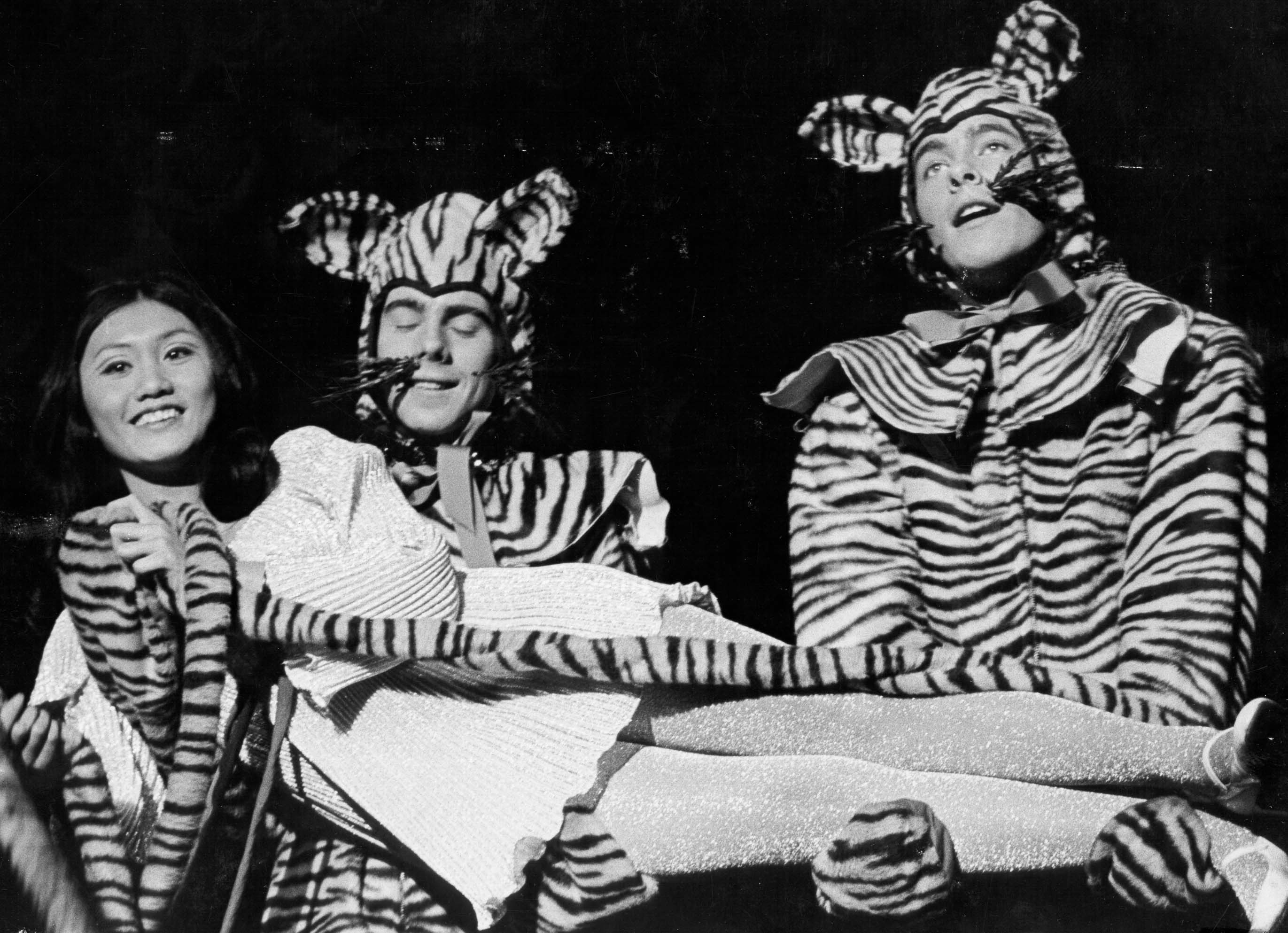
In 1968 “A Different Kick” marked a Triangle milestone. It featured the first female undergraduate to be cast in a Club show, Sue Jean Lee ’70, above, with Fred Davis ’70 (left) and George Cowen ’69 (right).
“Times They Are A-Changin,’ ” the new exhibition at the Seeley G. Mudd Manuscript Library, draws upon the library’s holdings to look back on a transformative era in the University’s history — the years between 1958 and 1983. The exhibition opens Friday, Feb. 22, and runs through Tuesday, July 15.
Using a montage of photographs, the exhibition describes in visual terms the changing order of life on campus: coeducation, the rise of computing technology, the formation of new academic departments, the restructuring of residential life, political activism by Princeton students during the 1960s and 1970s, and the vast changes that occurred to the campus physically, during President Robert Goheen’s tenure particularly.
Notable exhibition items drawn from the University Archives reflect the vast and varied holdings of the library itself. These include the Princeton flag that landed on the moon at the “Ocean of Storms” in August 1969, carried by 1953 alumnus Charles Conrad Jr., Princeton’s only lunar astronaut and commander of Apollo 12. The tome-like “The Education of Women at Princeton” attests to the thorough nature of Princeton’s analysis in creating a coeducational university. The exhibition also includes the 1967 cover of Sports Illustrated featuring 1967 graduate Gary Walters and 1969 alumnus Chris Thomforde, stars of the nationally ranked 1966-67 basketball team, and a promotional poster for Triangle Club’s performance of “Breakfast in Bedlam” in German. Other interesting memorabilia include a gold spike, matchbook and program commemorating the football game played between Rutgers and Princeton in 1969, which marked the one hundredth anniversary of the first intercollegiate football game ever played.
This exhibition also honors and reflects on the experiences of the classes of 1958 and 1983, which celebrate their 50th and 25th reunions, respectively, May 29-June 1. This portion of the exhibition draws from a wide variety of photographs, documents and memorabilia to recall notable events on campus during these classes’ tenures.
Among the events and items that are highlighted for the class of 1958 are The Daily Princetonian coverage of the “Rock ‘n’ Roll Riot” of 1955, when a mob of students caused mischief on campus while blaring the hit song “Rock Around the Clock”; a football program honoring beloved coach Charlie Caldwell; and the metal stencil used to create the 1958 class jacket.
Events documented for the class of 1983 include a Caribbean comic book honoring the 1979 Nobel Prize winner in economics and Princeton professor W. Arthur Lewis; a comical cover designed by 1984 alumnus Henry Payne for the 1983 Princeton-Columbia football game; photographs of classmate and future Olympian Lynn Jennings; and of the kickline from the Triangle Club number “White Laced and Wonderful” from the production of Under the Influence.
“Times They Are A-Changin’ ” is open to the public without charge from 9 a.m. to 4:45 p.m. Monday through Friday and until 7:45 p.m. Wednesday. The Mudd Library will be open from 9 a.m. to 1 p.m. Saturday, Feb. 23, for Alumni Day and Saturday, May 31, for Reunions. Beginning in June, exhibit hours will be 8:45 a.m. to 4:15 p.m. Monday through Friday and until 7:15 p.m. Wednesday.

One response to “Archives exhibition documents Princeton’s transformation”
I was confused about this caption and asked a Triangle alumnus about it. Below is our exchange.
Linke: I am confused about this caption though it appears accurate from the sources we have. Co-education was approved in Spring 1969 for implementation in the fall. Assuming that Sue Jean Lee came to Princeton in Sept. 1969, how is it that the show “A Different Kick” is dated as 1968? Also, would a member of the class of 1969 (who should have graduated in spring 1969) return for the fall show?
From: Geoff Peterson ’69
“A Different Kick” had it’s World Premier at McCarter in Dec. ’68, with Sue Jean making her precedent-setting debut. Here’s the explanation…
1) Sue Jean did not come to Princeton as a result of the “Co-education” decision. She was already on campus as a so-called “Critical Languages” student, a program that allowed women who had matriculated at other universities and colleges to attend Princeton for a year or more in order to pursue their particular [foreign] language, for which Princeton had a course of study but their own school did not.
2) While the Trustees’ formal decision to approve Co-education lay in the future, everybody knew it was coming. Triangle’s recruitment of Sue Jean to be the first Triangle female cast member was a play to get out in front of what was coming.
3) Sue Jean must have then formally transferred to Princeton after Co-education was approved, since Alumni Records show her as a Class of ’70 alumna. In the fall of ’68, she would have been the equivalent of a Junior.